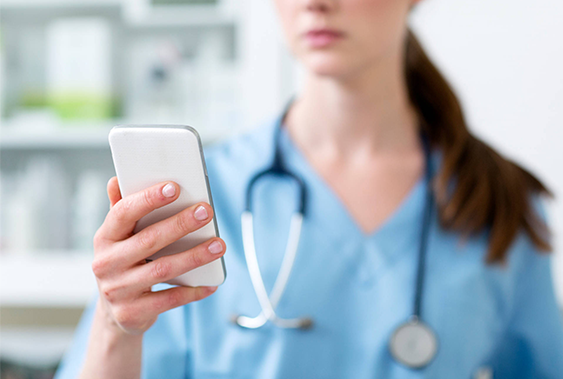Behind-the-scenes technology. Better inpatient care.
When EMS (emergency medical services) is called to assist a critically ill patient, the race is on to get the patient evaluated, transported and admitted to the hospital as quickly and safely as possible. With the patient in mind, care teams must work swiftly and make important care decisions. That’s why it’s vital that they have the right technology and quick access to the patient’s health care history.
When every second counts.
From the moment EMS arrive on scene, every second counts. Knowing important details of the patient’s status before the patient arrives to the ED (emergency department) helps clinical teams prepare and saves valuable time.
With the new Pulsara app, paramedics and EMTs can alert the ED that a critical patient is on the way to the hospital. Pulsara makes it easy to send a patient’s vital signs and other information, before the patient arrives at the ED. The ED can then organize the right clinicians, so they’re on standby, ready to act.

Getting the whole story. Better care, better outcomes.
While the Pulsara app is used between paramedics/EMTs and ED staff, before the patient arrives, the hospital clinical teams can be notified to be prepared for a patient arrival by the core clinical communication systems used by the hospital, such as Secure Chat or PerfectServe.
Epic gives the patient’s care team quick access to the patient’s full health care story in one integrated patient record, facilitating more coordinated, efficient care. A newly admitted patient’s care team can immediately access important details about the patient — like previously entered progress notes, lab and radiology results, allergies, diagnoses, etc. This gives them more complete, up-to-date information about the patient, at the point of care, helping them to make better care decisions, facilitating better outcomes.
If the patient was cared for by another health system that uses Epic, the patient’s provider can securely access vital patient information from the other facility through CareEverywhere. It allows clinicians from different organizations to quickly exchange important patient information. This helps them to better coordinate care, and learn about the history of the patient.
Mobile technology. On-the-go inpatient care.
In the hospital setting, clinicians are moving fast, caring for multiple patients and can’t be tethered to a computer, so it’s important that they have the right tools to use on the go.
While providers make hospital rounds, work in clinics or work from home, Epic mobile tools, Haiku and Canto, can help them stay connected to their admitted patients via smart devices.
Nurses, PCA techs and other hospital staff can document care on the go with Rover. This simplified version of Epic on a mobile device allows them to do limited clinical documentation, take wound care photos and more!
If a care team member needs to communicate about a patient with other providers, nurses, clinicians and other staff — one-on-one or as a group — they can use Secure Chat. Secure Chat enables clinicians to securely text colleagues for non-emergent communications through their desktop, WOW or Epic mobile apps like Haiku, Canto and Rover.

With Secure Chat, providers can open the patient’s chart and place orders through Epic mobile tools, Haiku and Canto. Clinicians can also take pictures or share existing images, then easily send through a chat conversation and attach to the patient chart.
Keeping loved ones connected and patients engaged in care.
While clinical teams are working around the clock, caring for our patients, emotions are running high for patients and their loved ones, who want to be engaged in care decisions. Last year, we piloted a new initiative that leverages text and email messaging to keep our admitted patients’ loved ones up to date on their conditions, while they’re in the hospital. This is improving patient and family satisfaction.
Through Epic, inpatient providers can quickly and easily update multiple family members/loved ones on the patient’s condition. These texts/emails help ensure that anyone the patient designates to receive status updates, is accurately and consistently updated. Contacts are also notified when the patient is transferred, has a new room number/phone number and when the patient is being prepared for discharge.
Since its launch, we’ve received lots of positive feedback from patients’ loved ones, who’ve received these updates:

- “Texting helped me to learn the hospital process. It decreased the anxiety of not knowing what would happen.”
- “This is such a creative, heartfelt service! I’m going to recommend Methodist to all my friends.”
- “I could actually leave Mom’s side and not worry, because I knew you would update me.”
- “The updates helped keep my family’s time coordinated as my wife attended to business outside the hospital, while still being involved in my care.”
- “It kept me updated on what was going on, so I could make the best decision on when to come to the hospital and when to go.”
To keep patients engaged while they’re in the hospital, two years ago, HM launched the MyMethodist Patient tablet initiative that gives patients iPads to use while they’re in the hospital. These tablets are preloaded with many of the same apps enjoyed at home and are designed to educate, engage and entertain our patients from the convenience of their hospital beds. Patients can do things like view details about their conditions, treatments and recovery in MyChart, review educational materials related to their diagnoses, stay connected with family and loved ones, access the Houston Methodist Patient Guide, order physician- and dietician-approved meals at select hospitals and play games, listen to music and watch movies or TV shows.
Leveraging technology to keep patients first.
Whether it’s alerting hospital teams about an arriving patient’s critical condition, allowing providers quick and easy access to a patient’s full health care story or facilitating communication between care teams or even a patient’s loved ones, HM continues to drive innovative, patient-centric technology that puts our patients at the heart of everything we do.
